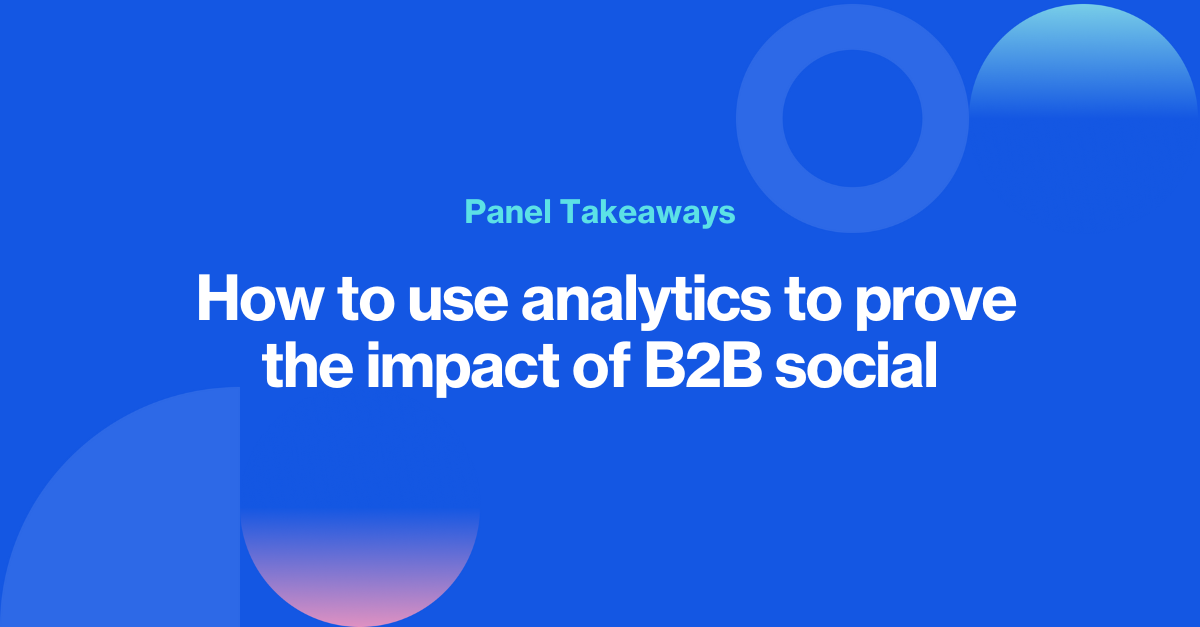
Straight from our panel: 7 ways to use analytics to prove the impact of B2B social
B2B marketers know that social media plays a pivotal role in the buyer journey, but proving its impact is another story. While engagement, reach, and impressions matter, leadership wants to see how those B2B social metrics translate into real business results: leads, pipeline, and revenue.
That’s why we brought in the experts to break it down. We hosted a powerful webinar with Matt Churchill, Social Media & Content Manager at AVEVA, and Madeleine Dudas, Associate Marketing Coordinator at Paycor, to share how they’re using analytics to prove the impact of social media on business outcomes.
Here are the top 7 takeaways from the webinar, straight from the experts.
1. Align your B2B social metrics with business objectives
Before diving into numbers, you need a clear framework for what social is meant to achieve.
Matt Churchill shared that AVEVA’s social media strategy is built around four pillars: employee advocacy, executive advocacy, regional enablement, and audience-centric content.
Each post is crafted to support one of these areas, which ensures that their analytics are always aligned with business priorities.
At Paycor, Madeleine Dudas structures her team’s goals around three objectives: brand awareness, thought leadership, and demand generation. Her reporting directly reflects how social contributes to these outcomes.
2. Track the metrics that matter most
Once your objectives are clear, focus on the metrics that help prove you’re making progress.
Matt’s team looks at engagement rate and awareness, but they go deeper by segmenting performance based on content type.
Madeleine Dudas puts a stronger emphasis on demand generation. Using Oktopost’s UTM tracking, they monitor website traffic, clicks, form fills, and how content influences lead creation and pipeline.
Recommended for further reading
3. Use data to guide your content decisions, not just measure it
Looking at metrics is one thing. Acting on them is where the magic happens.
Paycor uses monthly performance reviews to identify which types of content drive the most results. This helps their content and social teams stay aligned and make smart, data-backed changes.
Matt’s team at AVEVA has discovered that event recaps and in-the-moment content consistently outperform pre-event announcements, so they now focus more energy on timely, behind-the-scenes updates.
4. Custom reports for different internal teams
Reporting should never be one-size-fits-all. That’s why both teams tailor their insights depending on who they’re sharing with.
At Paycor, Madeleine Dudas runs:
- Weekly reports to catch standout content
- Monthly summaries to share with content and marketing teams
- Quarterly deep dives for leadership, focusing on lead quality, sales impact, and campaign ROI
To make these results digestible, they rely on Oktopost’s reporting dashboard to create easy-to-read visuals, export performance data, and highlight successes across departments.
At AVEVA, Matt Churchill monitors performance daily to stay on top of trends and provides monthly platform-by-platform reports that break down content type performance and audience engagement. These reports are shared with content teams and business stakeholders to inform campaign planning and content optimization. He also feeds quick updates back to the team when a post overperforms, helping them adapt content in real time.
5. Simplify your analytics to avoid overload
With so many data points available, it’s easy to lose focus. Matt Churchill recommends keeping your reporting clean and purposeful.
Rather than overwhelming stakeholders with every available metric, both teams stick to a shortlist of KPIs that directly map to business outcomes like engagement per post, click-through rate, and leads generated.
6. Tie social to pipeline and revenue
At Paycor, Madeleine Dudas goes beyond content performance. They track how social drives real business outcomes by integrating Oktopost with Salesforce to see the full journey from post to opportunity.
This includes:
- UTM tracking for every shared link
- Measuring form fills and content downloads
- Mapping social activity to meetings booked and deals influenced
This detailed view makes it easy to share results with leadership and proves the ROI of organic social.
7. Use analytics to fuel your advocacy program
Social analytics is also essential to building and maintaining a successful employee advocacy program.
Madeleine Dudas runs an internal advocate network at Paycor that includes top-performing sales reps. Using Oktopost, she tracks shares, reach, engagement, and even lead activity, making it easy to highlight real impact.
To keep momentum high, she shares performance highlights regularly, runs friendly competitions, and provides training based on what the data shows is working.
Start tying your hard work to revenue
B2B social media has moved far beyond impressions and likes. As Matt Churchill and Madeleine Dudas showed, the power of social lies in its ability to connect content to conversion, if you’re tracking the right metrics.
By aligning your metrics with business goals, refining your strategy with insights, and clearly communicating your impact, you can turn analytics into one of your most valuable tools.
Want to see how Oktopost can help you connect the dots between B2B social and revenue? Get in touch with us, we’d love to chat!


